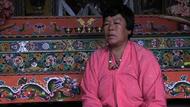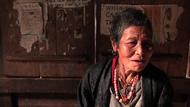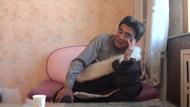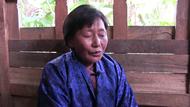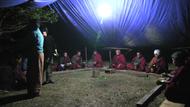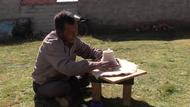Video Overview
A tangka painter in Lhasa sketches the tangka before painting.
- Lhasa
- Ü
- ལྷ་བྲི་བ། Tangka painterབྲིས་ཆུ་བཏང་པས།Did you apply the line marking solution?
- ལྷ་བྲི་བ། Tangka painterཐིག་འདི་དཀྱིལ་ཐིག་བཙལ་ཡག་བྱས། ཞུ་གུ་ཐིག་བརྒྱབ་དུས་This line is for finding the center point when later when we draw the lines.
- དགེ་ཕྲུག Apprenticeལཱ་སེ།Okay.
- ལྷ་བྲི་བ། Tangka painterའགྱིག་ཐིག་དེ་འཁྱེར་ཤོག་དང་།Bring the string.
- ལྷ་བྲི་བ། Tangka painterཕྱི་ལྟས་སློགས།Turn it around.
- ལྷ་བྲི་བ། Tangka painterལྟ་འགྲིག་སོང་། སྡུད་ཤོགYou can wrap it now.
- དགེ་ཕྲུག Apprenticeངོ་།Okay.
- ལྷ་བྲི་བ། Tangka painterརོབ་ཙམ་སྡུད་ཤོགKeep it away for a while.
- དགེ་ཕྲུག Apprenticeལགས་སོ།Okay.
- ལྷ་བྲི་བ། Tangka painterལྟ་དུས་རྒྱུན་ཡིན་ན་སྦྱངས་པའི་རི་མོ་བྲིས་དུས། ཐིག་གང་ཚང་རྒྱག་དགོས་ཀྱི་རེད་པཱ། ལྟ་ད་ལྟ་ངས་འདིར་ཐིག་ལྔ་ཐིག་ཞིག་བརྒྱབ་སོང་ང་། ལྟ་ཐིག་དེ་བསྡུས་པ་དེ་རེད།Normally you have to draw all the lines. But here I am only drawing the five main lines. This is the abridged version.
- དགེ་ཕྲུག Apprenticeལགས་སོ།Okay.
- ལྷ་བྲི་བ། Tangka painterཞུགས་མ་རི་མོ་ཡར་ཡག་པོ་ཆགས་སོང་ན་ཨ་ནི་ཐིག་བསྡུས་པ་དེ་བརྒྱབ་བྱས་རི་མོ་བྲིས་ཆོག སྐུ་ཆུང་ཆུང་དེ་ཚོར་སྤྱིར་བཏང་ཐིག་མེད་པ་བས་བྲིས་ན་འགྲིག་གི་རེད་པཱ།Later when you became sufficiently good at drawing, you can resort to this abridged version. For smaller figures, you can draw directly without lines.
- དགེ་ཕྲུག Apprenticeལཱ་སེ།Okay.
- ལྷ་བྲི་བ། Tangka painterད་ལྟ་གང་ག་ལོགས་སོར་ལྔ། གཅིག་དང་གཉིས་བྱས་བཅས་བྲིས་ཀྱི་ཡོག་རེད་པཱ།Right now you are drawing with all the detail lines, like five sors--or finger-widths--one sor, two sors and so on.
- དགེ་ཕྲུག Apprenticeལགས་འོ།Yes.
- ལྷ་བྲི་བ། Tangka painterལྟ་དེ་གས་བྲིས་མི་དགོས་བྱས་བཅས་ཐིག་དེ་བསྡུས་སུ་བཏང་བཞག་ཡོག་རེད་པཱ།Now here I simplified the number of lines required without all the details.
- དགེ་ཕྲུག Apprenticeལཱ་སེ།Okay.
- ལྷ་བྲི་བ། Tangka painterཐིག་གང་ག་བརྒྱབ་དགོས་བྱུང་བཞིན་རྙོག་ཁྲ་ཞེ་པོ་ཅིག་ཡོག་རེད།If we have to draw all the lines, then it is going to be very complicated.
- དགེ་ཕྲུག Apprenticeལཱ་སེ།Yes.
- ལྷ་བྲི་བ། Tangka painterད་ལྟ་གོང་ནས།Right from the beginning.
- ལྷ་བྲི་བ། Tangka painterད་དུང་སྐུ་ཆུང་ཆུང་དེ་གྲས་བྲིས་དགོས་བྱུང་ན། ཐིག་གང་ག་རྒྱག་ན་ཡོང་ཡག་ཁོ་ར་ཡོག་མ་རེད།Especially if one has to draw smaller figures, it is not helpful to use all the lines.
- དགེ་ཕྲུག Apprenticeལཱ་སེ།Okay.
- ལྷ་བྲི་བ། Tangka painterད་ལྟ་འདིར་ཐིག་ལྔ་འདུག་གཱCan you see the five lines here?
- དགེ་ཕྲུག Apprenticeའོ།Yes.
- ལྷ་བྲི་བ། Tangka painterའདི་ནས་ཕར་བཞི་བྱས། དེ་ནས་མར་གཞུང་ལ་ལྔ་བརྒྱབ་འདུག་གཱ འོ་འདི་བསྡུས་པ་དེ་རེད་དཱ། རི་མོ་འབྲི་དུས་ཙམ་ལ།Four lines horizontally here and five vertically from there. Can you see that? That is the abridged version.
- དགེ་ཕྲུག Apprenticeལཱ་སེ།Okay.
- ལྷ་བྲི་བ། Tangka painterཐིག་འདི་སྐུ་དྲག་པོ་དང་གང་ག་ལ་ཐིག་དཱ་ག་འགྲོ་གི་རེད།You can use this line rule for drawing all fearsome figures and others.
- དགེ་ཕྲུག Apprenticeལཱ་སེ།Okay.
- ལྷ་བྲི་བ། Tangka painterཐིག་གསུམ། དྲུག་བཏང་ཡག་དང་དེ་འདྲས་མ་གཏོགས་ཤིན་གང་ག་ལོགས་ཐིག་གཅིག་པ་རེད།Except for those drawings that require three or six lines. Otherwise, it is the same.
- དགེ་ཕྲུག Apprenticeལཱ་སེ།Okay.
- ལྷ་བྲི་བ། Tangka painterའཇམ་དཔལ་དབྱངས་དང་། སྤྱན་རས་གཟིགས། སྒྲོལ་ལྗང་། དེ་ཚོ་གང་ག་ཐིག་ལྔ་ཐིག་དེ་འགྲོ་གི་རེད།For drawing Manjuśri, Avalokiteśvara or Green Tara you can use the five lines method.
- དགེ་ཕྲུག Apprenticeལཱ་སེ།Okay.
- ལྷ་བྲི་བ། Tangka painterཕྱག་དང་དེ་ཚོ་ཡཱ་སོར་མོ་བཅུ་གཉིས་དང་དེ་འདྲས་གཏོང་དགོས་རེད།For the hand, you need twelve sors.
- དགེ་ཕྲུག Apprenticeལཱ་སེ།
- ལྷ་བྲི་བ། Tangka painterཕྱག་མགོ་འདིར་སོར་མོ་བཅུ་དྲུག་བཟོས།For the front of the hand use sixteen sors.
- དགེ་ཕྲུག Apprenticeལཱ་སེ།Okay.
- ལྷ་བྲི་བ། Tangka painterམདངས་སླ་པོ་ཞིག་རྒྱོབ་ཨཱ།Create a mild radiant.
- དགེ་ཕྲུག Apprenticeལཱ་སེ།Okay.
- དགེ་ཕྲུག Apprenticeད་ལྟའི་འདི་གང་བྱེད་ཀྱི་ཡོག་རེད།What is that you are doing now?
- ལྷ་བྲི་བ། Tangka painterལྟ་དེ་འདི་རེད་ལ། ཨམ་་་ གྲུ་བཀག་ཡ་ལ། ལྟ་ཐང་ཀའི་ནང་ལོགས་ཀྱི་ཚད་གཞི་འདི་བཟོ་གི་ཡོག་རེད།I am creating the boundary for the tangka.
- ལྷ་བྲི་བ། Tangka painterསྒང་འདི་ཚད་དང་། ཡཱ་ཙི། འོ་ཡཱ།Place it little above. Good.
- ལྷ་བྲི་བ། Tangka painterའོ་ཡགGood.
- ལྷ་བྲི་བ། Tangka painterཐིག་འདི་ཡག་པོ་བྱས་བྱས་མ་བརྒྱབ་པ་ཡིན་ན། རྗེས་མ་ཐང་ཀ་གོས་ཤམ་བརྒྱབ་དུས་ཀྱོག་ཀྱོག་ཆགས་འགྲོ་གི་རེད།If lines are not created precisely, later when you attach it to decorative cloths, it might get distorted.
- དགེ་ཕྲུག Apprenticeལཱ་སེ།Okay.
- ལྷ་བྲི་བ། Tangka painterགང་ག་འདིའི་ནང་ལོགས་འདིར་ཚུད་བསྡད་ཡོག་རེད།This includes everything.
- དགེ་ཕྲུག Apprenticeལཱ་སེ།Okay.
- ལྷ་བྲི་བ། Tangka painterའོ་ཡགGood.
- དགེ་ཕྲུག Apprenticeའགྲེལ་བཤད་ཏིག་ཙམ་སྐྱོན་རོགས་གནང་།Please explain a bit.
- དགེ་ཕྲུག Apprenticeཨམ་་་ ལྟ་འདིའི་འགྲེལ་བཤད་་་ ཨམ་་་ གང་ལབ་དགོས་ཀྱི་རེད།Um... An explanation for this, what to say?
- ལྷ་བྲི་བ། Tangka painterག་རེ་བྱེད་ཀྱི་ཡོག་རེད།What is that you are doing?
- ལྷ་བྲི་བ། Tangka painterལྟ་ད་ལྟ་རི་མི་འདི་བྲིས་ཚར་པ་རེད། ལྟ་གསལ་སློག་གཏོང་གི་ཡོག་རེད་པཱ། ལྟ་གསལ་ལོགས་བཏང་ཚར་སོང་ན་འདི་སྒང་ལ་སྣ་ཚས་བཅད་རྒྱབ། ཞུ་གུ་ཚོན་བཏང་ན་སྤྱིར་བཏང་གི་འདི་འདྲ་རེད།Now the drawing is complete. We are making it more visible. Then we use ink to create the outline. Later we apply the color.
- ལྷ་བྲི་བ། Tangka painterརྗེས་མ་ནས་རི་མོ་འབྲི་དུས་འཇམ་དཔལ་རང་ཨ་ནི་རི་མོ་དང་པོ་ཁོ་ར་ནས་གསལ་པོ་བྲི་རྒྱུ་ཡོག་མ་རེད།In the future, Jampel (Apprentice), you should not draw heavily right from the beginning.
- དགེ་ཕྲུག Apprenticeལཱ་སེ།
- ལྷ་བྲི་བ། Tangka painterདང་པོ་ཁོ་ར་ནས་གསལ་པོ་བྲིས་པ་ཡིན་ན། རི་མོ་ཡག་པོ་ཆགས་མེད་ན་བཟོ་བཅོས་རྒྱག་དུས་དཀའ་ངས་ཞེ་པོ་ཅིག་ཡོག་རེད།If you draw heavily at the outset and the drawing is not good, then it is difficult to correct it.
- ལྷ་བྲི་བ། Tangka painterག་ལེར་ག་ལེར་། གསལ་པོ་ཞེ་དྲགས་མེད་པ་ཞིག་བྲིས།Slowly; just create a rough drawing.
- དགེ་ཕྲུག Apprenticeལཱ་སེ།Okay.
- ལྷ་བྲི་བ། Tangka painterདེ་གས་གང་ག་ཆ་ཚང་བྲིས་ཚར་སོང་ན། གཞི་ནས་ཚུར་གསལ་རུ་བཏང་པ་ཡིན་ན་རི་མོ་ག་གི་ག་གི་ཆེ་ཆུང་ཤོར་ཡོད་མེད། ག་གི་ག་གི་ཆད་ཡོད་མས་དེ་གས་གང་ག་ཧ་གོ་རེད་པཱ།Only after the drawing is completed, when you make it more clear, will you know where the proportions are not right, where parts have been left out.
- དགེ་ཕྲུག Apprenticeལཱ་སེ།
- ལྷ་བྲི་བ། Tangka painterགཞི་ནས་འོ་དེ་གས་ཡར་བཅུག་བཞག་ན་འགྲིག་གི་ཡོག་རེད།Then you can fill in those missing parts.
- དགེ་ཕྲུག Apprenticeལཱ་སེ།Okay.
- ལྷ་བྲི་བ། Tangka painterདང་པོ་ཁོ་ར་ནས་གསལ་པོ་བྲིས་ཚར་ན། ཨཱ་ནི་རས་གཞི་ཁོ་རོ་ནག་ནོག་ཆགས།Drawing clearly right from the beginning, then canvas might become dirty if corrections are made.
- དགེ་ཕྲུག Apprenticeལཱ་སེ།Okay.
- ལྷ་བྲི་བ། Tangka painterཨཱ་ནི། འདི་་་ གསལ་པོ་ཡར་གསོས་རྒྱག་དུས་མངོན་གསལ་མེད་པ་ཆགས་འགྲོ་གི་རེད།Then when you clean it, there won't noticeable changes.
- དགེ་ཕྲུག Apprenticeལཱ་སེ།
- ལྷ་བྲི་བ། Tangka painterརི་མོ་དང་པོ་འབྲི་དུས་ཙམ་ལ་གཅིག་གསལ་ལ་མི་གསལ་བྲིས་ཡག་དེ་གལ་ཆེན་པོ་ཞེ་པོ་ཞིག་ཡོག་རེད།When you are starting the draw, it is crucial to draw it very lightly without clear marking.
- དགེ་ཕྲུག Apprenticeལཱ་སེ།
- ལྷ་བྲི་བ། Tangka painterཤོག་བུའི་སྒང་ལ་ཡིནའང་འདྲ། ག་པར་བྲིས་ནའི་ལས་གསལ་ལ་མ་གསལ་བྲིས།Be it on the paper, or on whatever surface, draw it without clarity.
- ལྷ་བྲི་བ། Tangka painterད་ལྟ་དེ་ཚོ་སོལ་སྤོས་རེད་པཱ། སོལ་སྤོས་འབྲི་ཡག་སོང་ཙང་། ཨཱ་ནི་ཕ་གིར་ཅིག་རི་མོ་འབྲི་ཡོང་དུས་ནས་ཏིག་ཙམ་དྲག་གི་རེད།Right now we are drawing with charcoal sticks, it is little bit easier.
- དགེ་ཕྲུག Apprenticeལཱ་སེ།Okay.
- ལྷ་བྲི་བ། Tangka painterབསུབ་བདེ་པོ་ཡོག་རེད་པཱ་ཁོ།It is easier to clean.
- བུད་མེད། Womanལྦ་ཡེ། འདུགHello! It's here.
- བུད་མེད། Womanབསངས་སྐོར་ཅིག་ཡོག་རེད་ཕ་གིར་བླུ་བཞག་ག ད་ལྟ་ཏིག་ཙམ་འདུག་གཱOne incense is left. Should I put it there? Right now we have some.
- ལྷ་བྲི་བ། Tangka painterའོ་རེད། བསང་སྐོར་ཉོས་ནའི་ཉོས།It is fine. If need to buy some, then buy it.
- དགེ་ཕྲུག Apprenticeའོག་གི་པདྨ་འདི་གས་ཚ་རུ་བཏང་།Does the lotus underneath need to be made more clear?
- ལྷ་བྲི་བ། Tangka painterའོ་འདི་གས་ཚ་རུ་གཏོང་དགོས་ཀྱི་རེད། ལྟ་མེ་ཏོག་འདི་གས། མཚོ་འདི་གས། ལི་ཁྲི་ནང་ལོགས་འདི་གས་ལ། ཏིག་ཙམ་ཏིག་ཙམ་བརྒྱབ་ཤོགYes these need to be made more clear. These flowers, lakes, inside the vermillion. Apply a little bit.
- དགེ་ཕྲུག Apprenticeལཱ་སེ།Okay.
- ལྷ་བྲི་བ། Tangka painterམཚོ་མཚོ་འདི་ཚོ་ཏིག་ཙམ་ཏིག་ཙམ་གར་པོ་ཞེ་དྲགས་མ་རྒྱོབ།Apply little bit to those small lakes. Don't make it thick.
- དགེ་ཕྲུག Apprenticeལཱ་སེ།Okay.
- ལྷ་བྲི་བ། Tangka painterལྟ་ད་ལྟ་ངས་བཀག་ཡག་དེ་ནོར་བུ་བཅོ་བདུན་ཟེར་ཡག་དེ་རེད།The scene I am creating in the front to block the background is called seventeen jewels.
- དགེ་ཕྲུག Apprenticeལཱ་སེ།Okay.
- ལྷ་བྲི་བ། Tangka painterམདུན་གྱི་དེ་གཉིས་འདོད་ཡོན་སྣ་ལྔ་བྱས།The front two are called five desires.
- དགེ་ཕྲུག Apprenticeལཱ་སེ།Okay.
- ལྷ་བྲི་བ། Tangka painterཨཱ་ནི་ཁག་ཅིག་ལ་ཡང་བཀྲ་ཤིས་རྟགས་བརྒྱད་བཟོ་འདྲ་བཏང་། ཡང་རྫས་བརྒྱད་བཟོ་དེ་འདྲ་བཏང་། ཡུལ་ལྗོངས་ག་རེ་བཀག་བཀག་ཡོག་རེད་ཐང་ཀ། ནོར་བུ་རིགས་ཆས་ཡིན་པའི་ཞུ་གུ་ཡུལ་ལྗོངས་ག་རེ་བཀག་ནའི་འགྲིག་གི་རེད། ལྟ་ད་ལྟ་འདིར་ངས་ནོར་བུ་བཅུ་བདུན་རེད་པཱ།In some cases, they use eight auspicious signs. Or like the eight auspicious articles. So long they are precious things you can block the background with them in tangka painting, You can put anything in the front. The one I used here is the seventeen jewels.
- དགེ་ཕྲུག Apprenticeལཱ་སེ།Okay.
- ལྷ་བྲི་བ། Tangka painterནོར་བུ་བཅུ་བདུན་བྱས། འདི་གཉིས་གཉིས་འདོད་ཡོན་སྣ་ལྔ་བྱས།These two are five desired symbols.
 Loading ...
Loading ... 